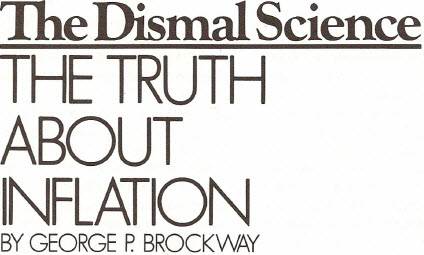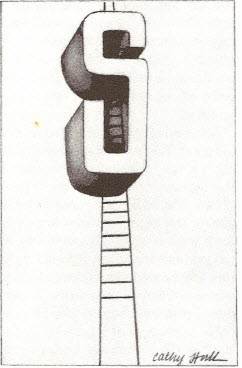By George P. Brockway, originally published June 3, 1996
THE ENTRY in this space for April 5, 1982, was titled “Let’s Put Indexing on the Index.“ The occasion was a Reagan Administration announcement of a shift in the Consumer Price Index (CPI). Fewer citizens than previously, it had been discovered, were buying houses.
There was a reason for that. The going interest rate for mortgages had reached 15.84 per cent. You may be sure there were “points” and lawyers’ fees and title insurance and surveyors’ fees and such to pay, too. As a result, the real estate market was sluggish, despite the fact that the children of the Boomer Generation were coming on line. With fewer houses sold, fewer mortgages were undertaken. Although the interest rate was out of sight, consumers had less interest to pay because not as many of them could afford it.
So the Bureau of Labor Statistics reduced mortgage interest as a factor in the CPI. This shrank the index as a whole and President Ronald Reagan got credit for controlling inflation, which President Jimmy Carter had not been able to do. Now a similar scheme is being suggested.
Federal Reserve Board Chairman Alan Greenspan, who seems to have been the scheme’s most prominent publicist, has a new and original end in view: He wants to turn the CPI into something it never was intended to be, in order to solve a problem no one thought existed.
From its beginning in 1919 the CPI, issued monthly by the Bureau of Labor Statistics, has shown the changes in what urban consumers shell out for the goods and services they buy – commonly referred to as a “market basket.” (Farmers get much of what they consume “free.”) As with any index, the items in the basket are weighted to reflect how frequently they appear on the typical shopping list. It was the “weight” of mortgage interest, for instance, that was scaled down in 1982.
Alone, an index number means nothing. You must have at least two numbers that are put together in the same way for a comparison to be possible. The CPI is a series of numbers. Similar series are created by those trying to compare the price levels of different countries and periods.
The CPI is used by historians as well as economists. And it is not discriminating. It does not try to measure the cost of what consumers ought to spend their money on; rather, it tells us what urban consumers do spend their money on. Over the long run, it needs periodic adjustments to accurately reflect the basket’s cost. In the short run, it is a measure of inflation and deflation.
Fear of inflation has been the economic neurosis of our time. Especially after World War II, it became common for contracts to contain Cost of Living Adjustments, or COLAS. The purpose was to ensure that no party to a contract either profited or lost from shifts in the price level. In 1972 and ’73 the idea was adopted for Social Security benefits. In 1986 the tax brackets in the Federal Income Tax were “indexed” to the CPI, so that taxpayers would not find themselves creeping into higher brackets even though their “real” incomes had not changed. Now COLAS appear in many kinds of contracts, public and private. Bankers also have long charged borrowers an inflation premium that is a COLA in everything but name.
What has been happening since Greenspan said last year that the CPI “overstates inflation” and should be corrected would be ludicrous if it were not liable to cause havoc in millions of lives. It seems that either the Reserve Board Chairman or someone with access to him happened to notice one day that the CPI doesn’t measure the cost of living. As we have seen, it never pretended to. Moreover, if Chairman Greenspan had time to stop and think, he would not only realize that the CPI is what is wanted in the sort of situation described above[1], but that the cost of living in a literal sense has nothing to do with it.
In sad fact, it is probable the whole mess was caused by the childish attraction almost everyone in the government and the media seems to feel for acronyms. One imagines a publicity flack being given the job of announcing a contract that provided for “an adjustment of compensation to offset, nullify, and render nugatory substantial shifts, if any, in the price level.” After much fretting and black coffee, the flack, inspired, rushes in to the director of public relations, whose door is always open. “Look, chief,” she or he cries, “let’s drop all this garbage. Let’s call it a ‘cost of living adjustment.’ Then for short we can call it a ‘cola.’ Get it?” The chief says, “Not bad.” Then he or she shows how he or she got to be chief. “We’ll run it in caps,” he or she adds softly, taking out a pad and a Mont Blanc pen and printing the word in big capitals: “C 0 L A.” The rest is history.
Possessed of the misapprehension that when people spoke of COLAS they truly meant what it cost to keep a person alive, Chairman Greenspan, though scarcely a close student of the physiological form of the problem, saw that many of the factors in the CPI were not essential costs of living. One hypothetical example seems to appeal to most of those who have taken up the idea. Think of beef, they say; everyone knows its price has gone up, but no one has to eat it, even in England. Chicken is not only cheaper, it’s better for you (less cholesterol, unless you persist in frying it); so chicken should be in the CPI basket instead of beef. That way, the cost of living would be less.
The reasoning would be impeccable if the CPI were supposed to measure the cost of living. Indeed, in that event the argument could be carried a step or two further. Bread (whole wheat or oatmeal, of course) is cheaper than chicken. Cake, as Marie Antoinette discovered, is not cheaper than bread, but rice (unhulled, of course) is. No doubt there are even cheaper ways of keeping body and soul together, but I’m not anxious to know about them. I can already hear King Lear: “0, reason not the need! Our basest beggars are in the poorest thing superfluous. Allow not nature more than nature needs: Man’s life is cheap as beast’s.”
Not even Speaker Gingrich is likely to argue openly that the cost of biological existence is all that should concern us. Nor does Chairman Greenspan, who has noted that the CPI may be overstated in part because it overlooks shoppers who switch to bargain brands and discount stores, really believe the index should tell us citizens what to eat and, afortiori, how to clothe and shelter ourselves. For my part, I do not think that there shall be no more cakes and ale, and I doubt that either the Chairman or the Speaker thinks so. The cost of living, as Lear implies, may well require a standard, but index numbers are compared with each other, not an exogenous standard.
THAT BRINGS us back to the purpose of COLAS. They are not, and never have been, intended to lift Social Security benefits up to the poverty level. They couldn’t do that at any acceptable cost if we wanted them to. In the case of union contracts, they would not be worth bothering about if poverty were the best they could guarantee. No, the COLAS were and are meant to offset the effects of inflation.
Needless to say, the CPI is not a perfect yardstick. In particular, there are serious difficulties with the way the housing component is calculated that result, as Dimitri Papadimitriou and L. Randall Wray of the Jerome Levy Economics Institute have shown, in an accelerating upward bias of the index. On the other hand, when senior citizens cozy up to the fireplace on cool evenings, they are apt to exchange anecdotes about how everything costs a great deal more than it used to.
Having said all that, let me say further that I am opposed to indexing in principle, for it is always and everywhere inflationary. In every case where, as in the Weimar Republic, a runaway inflation has occurred, indexing has been at the bottom of it.
But, as I’ve written before, “Bankers Have the Classic COLA” (NL, January 9, 1989), and as long as they have it, the rest of us are entitled to all the CPI-driven benefits we can get. With the support of economic theorists, bankers (and lenders generally) divide the interest they charge into two parts: “real interest,” which is what they would charge in a stable economy, and their COLA, or “inflation premium,” which is generally said to be the same as the year-to-year change of the CPI. At first glance this seems as reasonable as any other COLA, but it doesn’t work out that way, because the total indebtedness of the nonfinancial sectors of the economy (you, me, the corner store, and the government) is almost double the GDP.
In other words the total Bankers’ COLA, while supposedly designed to protect lenders from inflation, is about double what inflation costs the whole economy (lenders and borrowers and everyone). The arithmetic is apparently too simple for most economists to understand: In 1995, the rate of change of the CPI was 2.5 per cent; the total indebtedness was $13,804.2 billion; so the Bankers’ COLA was .025 x$13,804.2 billion, or $345.1 billion. At the same time, the GDP was $7,297.2 billion, which, when multiplied by .025, gives $182.4 billion as due to inflation. Take away the Bankers’ COLA of $345.1 billion, and the economy is in deflation, not inflation.
I am, you may be sure, aware that the 1995 CPI applies only to indebtedness incurred in 1995, which is only about a twelfth of the total. The other eleven twelfths include mortgages and Treasury bonds stretching back to 1965, though almost all debts are of more recent vintage (the average length of current public debt is less than six years). The key point is that in only one of those 30 years (1986) was the change in the CPI lower than in 1995. In short, taking 2.5 percent as the Bankers’ COLA rate for all debts outstanding in 1995 gives lenders a generous benefit of a serious doubt, particularly since it is not unknown for individual bankers to figure more than the CPI as the inflation premium.
In sum, if there were no Bankers’ COLA, there would now be no inflation, hence no occasion for all the other COLAS, hence no need for Chairman Greenspan to raise the interest rate to “fight inflation,” nor for Speaker Gingrich to weary himself dreaming up arcane tricks to play on the elderly.
Furthermore, although I am not scared silly by the present deficit, I am terrified by and ashamed of the budgeteers’ mindless and compassionless trashing of American culture and civilization. Therefore
I want to point out that if the Board Greenspan chairs devoted itself to getting rid of the Bankers’ COLA, it could lower the interest rate and put us on a fast track to a balanced budget and a more humane and more prosperous America.
The New Leader
[1] Ed – the author is not here to ask but this is the link we believe he is making here




